NancyYvonne
The Force is Strong With This One
There are the remains of a city on Mars that can be seen at ? At first glance, it just looks like piles of broken and eroded sandstone littered everywhere, but if you look close there are all kinds of adornments and scenes on them. They appear to be sandstone walls with with metal beams sandwiched between them and columns made of metal rods that are then encased in sandstone or a sandstone composite.

Upper wall with faces, figures, and a metal beam.

Bundled metal rods with remnants of limestone. Designs on the wall laying on the rods.

Column with metal beam interior and ornamented sandstone exterior.

Metal rods behind facade.

The tops of many of these walls are layered presenting a 3D like visuals with scenes of people, animals, and architectural lines.

What first got my attention on this gigapan was this huge chair. Those lines are not natural. Turned sideways, you can see a woman sitting in the chair and her arms are held like she was holding an instrument like a lute at one time. The front rung of the chair looks like a giraffe with a twisted neck.
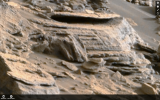
Chair sideways.

Near the chair is a statue of a lower torso of a man, part of an alcove. The piece to the left looks like the upper torso with wings. Below that is a cauldron with a lid and two faces, probably part of the wall.
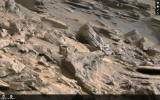
Closeup of cauldron and stone faces.
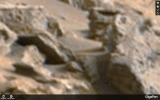
To the left and up is a seated winged cow holding a scepter and a lidded vessel lies under her head .

This is an entryway into one of the buildings, note the architectural lines on it.

Closeup of doorway opening, sand and a fallen rock with this section.
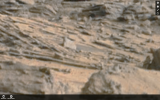
Everywhere you look, there are tumbled buildings. The rocks that have fallen from the top onto the buildings below also have designs on them.

This is on the far left of the gigapan. Looks kind of like a flying vehicle sandwiched between those two rocks.

At the top of the hill there appears to be stairs leading to a gabled entryway and a building
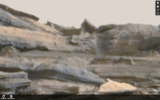
At first this looks like a UFO, but this is a large cauldron and the handle of the lid is broken. Could this cauldron be for smelting? There is a statue on the ledge above.

I have many more screen shots, but have run out of the 20 image limit. Maybe I will do a followup post with a few more screen shots. There are collapsed buildings from one end of this gigapan to the other. Debris from the buildings lie everywhere and I find something new each time I look at it. I have also found two more gigapans with debris. They are not as extensive as this one but still impressive. I now think that the trick to finding more than one artifact is to look for gigapans that have hills and depressions where there may have been bodies of water or rivers. The gigapans with vast flatland may offer an artifact or two, but it is a waste of time. People might have traveled through the area, but they didn't live there.

Upper wall with faces, figures, and a metal beam.

Bundled metal rods with remnants of limestone. Designs on the wall laying on the rods.

Column with metal beam interior and ornamented sandstone exterior.

Metal rods behind facade.

The tops of many of these walls are layered presenting a 3D like visuals with scenes of people, animals, and architectural lines.

What first got my attention on this gigapan was this huge chair. Those lines are not natural. Turned sideways, you can see a woman sitting in the chair and her arms are held like she was holding an instrument like a lute at one time. The front rung of the chair looks like a giraffe with a twisted neck.

Chair sideways.

Near the chair is a statue of a lower torso of a man, part of an alcove. The piece to the left looks like the upper torso with wings. Below that is a cauldron with a lid and two faces, probably part of the wall.

Closeup of cauldron and stone faces.

To the left and up is a seated winged cow holding a scepter and a lidded vessel lies under her head .

This is an entryway into one of the buildings, note the architectural lines on it.

Closeup of doorway opening, sand and a fallen rock with this section.

Everywhere you look, there are tumbled buildings. The rocks that have fallen from the top onto the buildings below also have designs on them.

This is on the far left of the gigapan. Looks kind of like a flying vehicle sandwiched between those two rocks.

At the top of the hill there appears to be stairs leading to a gabled entryway and a building

At first this looks like a UFO, but this is a large cauldron and the handle of the lid is broken. Could this cauldron be for smelting? There is a statue on the ledge above.

I have many more screen shots, but have run out of the 20 image limit. Maybe I will do a followup post with a few more screen shots. There are collapsed buildings from one end of this gigapan to the other. Debris from the buildings lie everywhere and I find something new each time I look at it. I have also found two more gigapans with debris. They are not as extensive as this one but still impressive. I now think that the trick to finding more than one artifact is to look for gigapans that have hills and depressions where there may have been bodies of water or rivers. The gigapans with vast flatland may offer an artifact or two, but it is a waste of time. People might have traveled through the area, but they didn't live there.






